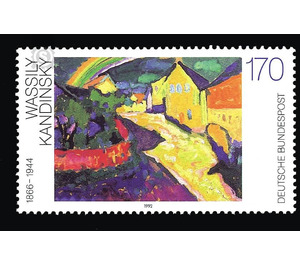German painting of the 20th century (1) - Germany / Federal Republic of Germany 1992 - 170 Pfennig
Theme: Art & Culture
| Country | Germany / Federal Republic of Germany |
| Issue Date | 1992 |
| Face Value | 170.00 |
| Color | multi-colored |
| Perforation | K 13 3/4: 14 |
| Printing Type | Multicolor offset printing |
| Stamp Type | Postage stamp |
| Item Type | Stamp |
| Chronological Issue Number | 1492 |
| Chronological Chapter | GER-BRD |
| SID | 401478 |
| In 48 Wishlists | |
Wassily Kandinsky, a Russian lawyer who had devoted himself to painting since 1896, and Franz Marc, a "true Bavarian," met each other in 1910 in Munich, the then leading German art metropolis. Kandinsky's novel and idiosyncratic, s. The often scolded painting, his struggle against the hated authority of the Academy, and his revolt against the firmly established concept of conservative Munich cultural life had aroused the attention of Franz Marc, so that the Munich-born, as yet unknown painter had a connection to the almost 15 years older Kandinsky, from Moscow, searched. This was the beginning of a friendly, German-Russian relationship on Bavarian soil, from which the Russian-Bavarian »Blaue Reiter« emerged in 1911. The Rheinländer August Macke came to the circle of employees in the same year. The "Blaue Reiter" was not a group of artists in the narrower sense of the word, but the editors of an almanac, which contained text and image samples from various independent artists. Kandinsky was then convinced that the creation of a community of artists would - almost inevitably - lead to endless discussions and quarrels; regularly these conflicts led to a split, if not to the dissolution of the union. The aim of the almanac "The Blue Rider", which first appeared in 1912, was therefore by no means to create an artistic movement, but the editors of the yearbook wanted to reflect in the diversity of their contributions already existing trends of expressionist art. The existence of the "Blue Rider" came to a sudden end with the outbreak of the First World War. Every significant expression of art speaks its own language, every art has only its peculiar means. One of the means of expressing expressionist imagery is, above all, a lively, sometimes even stormy, color. Kandinsky and some of his contemporaries choose the hues of their pictures vigorously, in decided contrasts. A large-scale, almost extravagant color design breaks out in all clearness, so that the content of the images becomes increasingly difficult to read. Kandinsky, for example, has not clarified details of his subjects since 1908. This inclination is not only his personal nature. The Expressionists generally renounce a clean, sharp treatment of the figurative, which reaches to the finest detail. It seems essential that in Kandinsky the color values acquire an independence which the older painting had barely permitted. From here, the art-historical path led to a radical renewal of painting, to purely colored surface design, in short: to abstract painting. The gradual detachment from the objective characterizes, broadly speaking, broad areas of art development at the beginning of the 20th century. In Franz Marc's highly unrealistic color design is obvious. It almost seems as if the respective motif is just a pretext and occasion for unfolding shades of great luminosity. Of course, pictorial realism is an art concept that runs counter to paintings of this kind. The search for a proper reflection of natural phenomena in the medium of images is alien to Expressionism. The opposite seems to be the case. Franz Marc, who has been insufficiently labeled as an "animal painter", emphasizes in any case: "Art in its essence was and is always the most daring distance from nature and naturalness, the bridge to the spiritual realm ...". Kandinsky, Marc and Macke are today among the most important European painters of the 20th century, they have their place in the great museums. Her historically momentous contribution to international modernism is undisputed. At the beginning of our century, however, her manner of painting did not correspond to the prevailing taste. Rather, the Expressionist style of art was disturbing and confusing to the viewer, the images triggered a storm of outrage. Kandinsky has described the recording of his Munich work in public as follows: "The press let go of all their anger against the exhibition, the audience scolded, threatened, spat ... on the pictures." In view of this mocking lack of understanding, Franz Marc had to declare in his preface to the Blue Rider (2nd ed.) In 1914: "We do not know that the great crowd can follow us today; her is the way too steep and unbroken «. The extreme radicalism of the rejection of modern paintings was achieved in Germany with the Nazi iconoclasm, an iconoclasm to which countless great works of German art have fallen victim. In the times of the militant National Socialist cultural policy, the images of the Expressionists - like all non-naturalistic painting - were shamelessly defamed as evidence of cultural Bolshevik degeneration. Franz Marc had demanded in 1912 that he and his artist friends should "show their pictures as a matter of course," as a matter as self-evident as a stamp. (Text: Luise Leinweber and Marcus Kiefer, Kunsthistorisches Institut der Universität Bonn)


